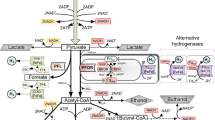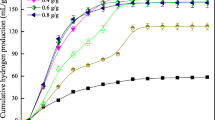Abstract
Dark fermentation holds promise as a strategy for biohydrogen production, utilizing a wide range of biomass substrates and aiding in waste management. However, it typically exhibits lower yields compared to conventional thermal processes such as reforming. To overcome this limitation, the use of additives to enhance microbial activity and improve yields has been explored. However, the application of organic and inorganic additives in dark fermentation remains limited. This study aims to address this gap by examining the effects of three types of compounds (zero valent iron nanoparticles or NP Fe(0), active carbon, and hydrochar) on dark fermentation and hydrogen generation. Notably, hydrochar exhibits the most promising results, increasing H2 production by 20.3%, with the highest biohydrogen yield being 92 mLH2/g of glucose. The distribution of volatile fatty acids indicated that the butyric and acetic pathways were utilized for H2 production. It is also important to consider the alkalinity of the feedstock, as high levels can increase the pH in the media and favor the production of methane (CH4) as the main fermentation product. In this case, NP Fe(0) is revealed as the additive that most favors methane generation, resulting in 6.1% higher production compared to the control assay. The analysis of the microbial community revealed that the digestate from an anaerobic reactor of a municipal wastewater treatment plant contains 4.24 times more Clostridium sensu stricto 1 than that from a sugar beet digester, which promotes the sustainable conversion of carbonaceous matter into hydrogen.







Similar content being viewed by others
References
R. Łukajtis, I. Hołowacz, K. Kucharska, M. Glinka, P. Rybarczyk, A. Przyjazny, and M. Kamiński, Sustain. Energy Rev. 91, 665 (2018).
A.K. Pandey, S. Pilli, P. Bhunia, R.D. Tyagi, R.Y. Surampalli, T.C. Zhang, and A. Pandey, Chemosphere 288, 132444 (2022).
A. Klindworth, E. Pruesse, T. Schweer, J. Peplies, C. Quast, M. Horn, and F.O. Glöckner, Nucleic Acids Res. 41(1), e1 (2013).
V. Jayachandran, N. Basak, R. De Philippis, and A. Adessi, Bioprocess Biosyst. Eng. 45(10), 1595 (2022).
J.F. Soares, T.C. Confortin, I. Todero, F.D. Mayer, and M.A. Mazutti, Renew. Sustain. Energy Rev. 117, 109484 (2020).
A.M. Lopez-Hidalgo, A. Smoliński, and A. Sanchez, Int. J. Hydrogen Energy 47(27), 13300 (2022).
G. Yang and J. Wang, Renew. Sustain. Energy Rev. 95, 130 (2018).
C. Lu, G. Wang, Q. Zhang, X. Yang, J. Yu, T. Liu, and H. Zhang, Appl. Energy 347, 121463 (2023).
V.G. Sharmila, K. Tamilarasan, M.D. Kumar, G. Kumar, S. Varjani, S.A. Kumar, and J. Banu, Int. J. Hydrog. Energy 47(34), 15309 (2022).
R. Sirohi, V. Vivekanand, A.K. Pandey, A. Tarafdar, M.K. Awasthi, A. Shakya, and A. Pandey, Environ. Technol. Innov. 30, 103100 (2023).
J. He, S. Ren, S. Zhang, and G. Luo, Bioresour. Technol. 341, 125856 (2021).
P. Wu, Z. Wang, A. Bhatnagar, P. Jeyakumar, H. Wang, Y. Wang, and X. Li, J. Hazard. Mater. 416, 125915 (2021).
N.S. Jamali, J.M. Jahim, and W.N.R.W. Isahak, Int. J. Hydrog. Energy 41(46), 21617 (2016).
C. Zhang, X. Kang, N. Liang, and A. Abdullah, Energy Fuels 31(11), 12217 (2017).
P. Wimonsong and R. Nitisoravut, R. Energy Fuels 28(7), 4554 (2014).
Z. Zhang, Z. Zhu, B. Shen, and L. Liu, Energy 171, 581 (2019).
A. Catenacci, G. Boniardi, M. Mainardis, F. Gievers, G. Farru, F. Asunis, and R. Canziani, Energy Conv. Manag. 263, 115691 (2022).
V. Kumar, R. Nabaterega, S. Khoei, and C. Eskicioglu, Rene. Sustain. Energy Rev. 144, 110965 (2021).
M. Cavali, N.L. Junior, R. de Almeida Mohedano, P. Belli Filho, R.H.R. da Costa, and A.B. de Castilhos Junior, Sci. Total. Environ. 822, 153614 (2022).
J. Bu, H.L. Wei, Y.T. Wang, J.R. Cheng, and M.J. Zhu, Water Res. 202, 117440 (2021).
J. Zhang, C. Fan, and L. Zang, Bioresour. Technol. 245, 98 (2017).
S. Ren, M. Usman, D.C. Tsang, S.O. Thong, I. Angelidaki, X. Zhu, and G. Luo, Environ. Sci. Technol. 54(9), 5755 (2020).
Y. Yang, M. Wang, S. Yan, X. Yong, X. Zhang, M.K. Awasthi, and J. Zhou, Chemosphere 310, 136876 (2023).
S. Shanmugam, A. Hari, A. Pandey, T. Mathimani, L. Felix, and A. Pugazhendhi, Fuel 270, 117453 (2020).
D. Hidalgo, J.M. Martín-Marroquín, and F. Corona, Biomass Convers. Biorefin. https://doi.org/10.1007/s13399-023-04103-1 (2023).
L. Zhang, L. Zhang, and D. Li, Int. J. Hydrog. Energy 40(36), 12201 (2015).
M. Taherdanak, H. Zilouei, and K. Karimi, Int. J. Hydrog. Energy 41(1), 167 (2016).
G. Yang and J. Wang, Bioresour. Technol. 266, 413 (2018).
Y. Ren, B. Si, Z. Liu, W. Jiang, and Y. Zhang, Int. J. Hydrog. Energy 47(3), 1499 (2022).
A.D. Eaton and M.A.H. Franson, Standard Methods for the Examination of Water and Wastewater, 21st edn. (American Public Health Association (APHA), Washington, DC, 2005).
M.H. Zwietering, I. Jongenburger, F.M. Rombouts, and K.J.A.E.M. Van’t Riet, Appl. Environ. Microbiol. 56(6), 1875 (1990).
A. Ahmad, K. Rambabu, S.W. Hasan, P.L. Show, and F. Banat, Int. J. Hydrogn. Energy. https://doi.org/10.1016/j.ijhydene.2023.05.161 (2023).
L. Luo, S. Sriram, D. Johnravindar, T.L.P. Martin, J.W. Wong, and N. Pradhan, Bioresour. Technol. 358, 127404 (2022).
M. M. Amin, M. Ghasemian, B. Bina, E, Taheri and A. Fatehizadeh, Health Scope, 8(2) (2019).
C. Mahata, S. Ray, and D. Das, Energy Convers. Manag. 219, 113047 (2020).
J. Grzelak, R. Ślęzak, L. Krzystek, and S. Ledakowicz, Ecol. Chem. Eng. S. 25(2), 295 (2018).
J. Yang, J. Zhang, J. Zhang, J. Zhang, Y. Yang, and L. Zang, Int. J. Hydrog. Energy 46(78), 38645 (2021).
G. Yang and J. Wang, Int. J. Hydrog. Energy 44(47), 25542 (2019).
P.S. Garcia, S. Gribaldo, and G. Borrel, Annu. Rev. Microbiol. 76, 727 (2022).
Acknowledgements
The authors gratefully acknowledge support of this work by the CDTI-Spanish Ministry of Science and Innovation in the frame of the project H24NEWAGE (Ref. CER-20211002).
Author information
Authors and Affiliations
Corresponding author
Ethics declarations
Conflict of interests
On behalf of all authors, the corresponding author states that there is no conflict of interest.
Additional information
Publisher's Note
Springer Nature remains neutral with regard to jurisdictional claims in published maps and institutional affiliations.
Rights and permissions
Springer Nature or its licensor (e.g. a society or other partner) holds exclusive rights to this article under a publishing agreement with the author(s) or other rightsholder(s); author self-archiving of the accepted manuscript version of this article is solely governed by the terms of such publishing agreement and applicable law.
About this article
Cite this article
Hidalgo, D., Pérez-Zapatero, E., Martín-Marroquín, J.M. et al. Comparative Analysis of Additives for Enhanced Biohydrogen Production via Dark Fermentation. JOM 76, 141–152 (2024). https://doi.org/10.1007/s11837-023-06231-5
Received:
Accepted:
Published:
Issue Date:
DOI: https://doi.org/10.1007/s11837-023-06231-5




